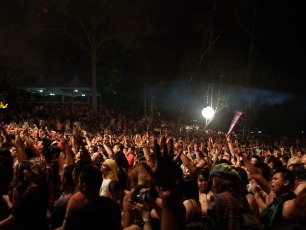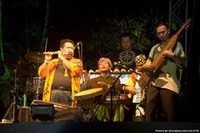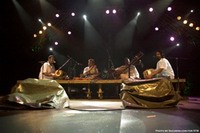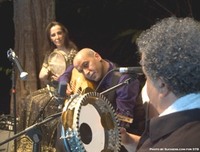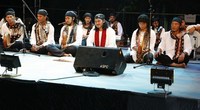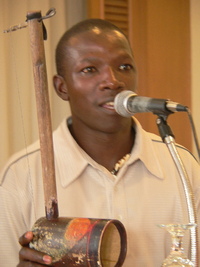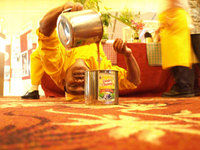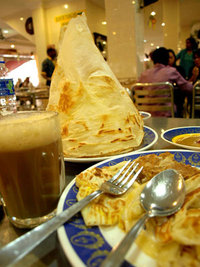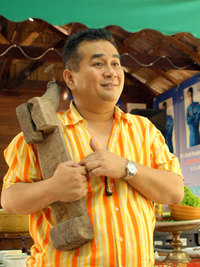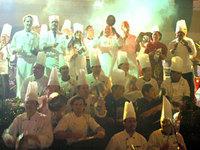by Mallika Naguran
Singapore, 13 April 2009. Jazz lovers will appreciate Miri as the staging ground of one of the top music festivals in Asia – the Miri International Jazz Festival from 8-9 May 2009. The nature-rich destination of Sarawak is already alluring; add world-class jazz strains to rainforests and national parks, you get a mixture that is both intoxicating and unforgettable.
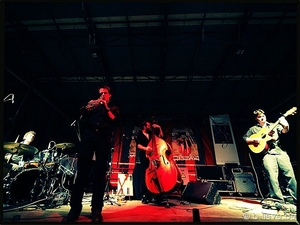
French dudes Dites 34.
The organisers, Sarawak Tourism Board, say that the festival, which is in its fourth year “promises to be another exciting event with wide repertoire of jazz genre”. Indeed the line up looks impressive (see below for full listing) with top bands keeling to kick up some profound blues, fusion, smooth, Latino to world. Leading artistes from around the world will blend heritage strains with musical acumen to get the audience tapping and bobbing away.
The Miri International Jazz Festival 2009 (MIJF) will feature the following performers: Dites 34 (France), Thomson Big Band (Singapore), Jeff Maluleke (South Africa), Alamode (Australia), Steps in Time featuring John Kaizan Neptune (Japan), Bombay Baja (India/England), Rumba Calzada (Canada) and Double Take (Malaysia). The festival is to be held at the Pavilion of the Park City Everly Hotel in Miri.
Miri is located in the northern part of Sarawak and attained its Resort City status in 2005. Often known as the Northern Gateway to Sarawak, the city is a popular base for visitors to explore the nearby national parks including Niah, Loagan Bunut and Lambir Hill national parks.The UNESCO World Heritage Mulu National Park is only a 45- minute flight away.
Jazz Line-up in 2009
Steps In Time featuring John Kaizan Neptune is a multi-cultural band that performs a mix of oriental, traditional and funky beats.John Kaizan Neptune has gained international reputation as the innovator on the Japanese bamboo flute, the Shakuhachi. One-sound-enlightenment shakuhachi blows with complex metre Indian drumming; cool jazz guitar glides with hot snaking Indian violin; funky wild bass grooves with rock steady drum set. At times calm or turbulent, free or calculated, a river of rhythm flows from multi-cultural Steps in Time.
Rumba Calzada was the crowd favourite last year.
Rumba Calzada is making its second appearance at the festival after being voted in survey as the crowd favourite in MIJF 2008. Led by Raphael Geronimo, the band had the crowd going crazy dancing to their blend of their Latino jazz with Afro Cuban rhythm.
Alamode - a six-piece jazz funk powerhouse - is reputed to deliver an amazingly tight and entertaining show.Known to always bring something new to each performance, Alamode is expected to woo the audience at the upcoming MIJF with their original funky tunes.
A leading Indian brass band in Europe, Bombay Baja Brass Band will create a carnival-like atmosphere with their unique style of combining popular Indian melodies with elements of jazz.Performing top Bollywood, Bhangra and Punjabi tunes as well as Indian wedding songs, Bambay Baja Brass Band will definitely entertain MIJF revelers who are Bollywood fans.
Jeff Maluleke is an award-winning South African guitarist, singer and songwriter. Although his music is very much afro-centric in character, Jeff Maluleke has also infuses a range of influences including Western tempo to create a distinct aesthetic that is sure to appeal to all music lovers.
Dites 34 performs a unique blend of traditional French folk music, contemporary jazz and pure energy.Making their Asian debut at the MIJF 2009, members of Dites 34 are no strangers to the music scene having shared the stage with some of the world’s leading artists during their tours of Europe and Mexico.
Thomson Big Band from Singapore.
A household name in Singapore jazz scene, the Thomson Big Band has also created a name for themselves outside the republic after having performed in major jazz festivals and events in Japan, Australia, India and Thailand.
Nearer to home is the Double Take duo of Roger Wang and Mia Palencia who are familiar faces in the local jazz scene in Malaysia. Combining Roger’s jazz guitar wizardry and Mia’s rich and sultry voice, the two will present their music in a pure and intimate form, performing jazz standards and original works.
More information:
Visit Miri International Jazz Festival website for further show and performer details. www.mirijazzfestival.com
Organisers Sawarak Tourism Board www.sarawaktourism.com
Tickets for adults are priced at RM60 per day and RM100 for a two-day ticket. Tickets for children between three and 12 years old are priced at RM30 per day and RM50 for two days. The two-day ticket will only be available until 25 April 2009. Following this date, only daily tickets will be on sale.
Tickets are also available online at www.ticketcharge.com.my.
Getting There:
Malaysia Airlines and AirAsia flies daily to Miri from Kuching, Kota Kinabalu and Kuala Lumpur.
Miri is just one hour flight away from Kuching, the capital city of Sarawak. Kuching, the main gateway to Sarawak, is also accessible via direct flight by Air Asia, Tiger Airways, Silk Air, Batavia Air, Royal Brunei Airways and MAS from Kuala Lumpur, Kota Kinabalu, Singapore, Jakarta, Macau, Pontianak and Brunei Darussalam.


